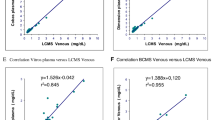Abstract
In order to monitor creatinine levels or to adjust the dosage of renally excreted or nephrotoxic drugs, the analysis of creatinine in dried blood spots (DBS) could be a useful addition to DBS analysis. We developed a LC-MS/MS method for the analysis of creatinine in the same DBS extract that was used for the analysis of tacrolimus, sirolimus, everolimus, and cyclosporine A in transplant patients with the use of Whatman FTA DMPK-C cards. The method was validated using three different strategies: a seven-point calibration curve using the intercept of the calibration to correct for the natural presence of creatinine in reference samples, a one-point calibration curve at an extremely high concentration in order to diminish the contribution of the natural presence of creatinine, and the use of creatinine-[2H3] with an eight-point calibration curve. The validated range for creatinine was 120 to 480 μmol/L (seven-point calibration curve), 116 to 7000 μmol/L (1-point calibration curve), and 1.00 to 400.0 μmol/L for creatinine-[2H3] (eight-point calibration curve). The precision and accuracy results for all three validations showed a maximum CV of 14.0 % and a maximum bias of −5.9 %. Creatinine in DBS was found stable at ambient temperature and 32 °C for 1 week and at −20 °C for 29 weeks. Good correlations were observed between patient DBS samples and routine enzymatic plasma analysis and showed the capability of the DBS method to be used as an alternative for creatinine plasma measurement.

From blood spot to chromatogram




Similar content being viewed by others
References
Edelbroek PM, van der Heijden J, Stolk LM (2009) Dried blood spot methods in therapeutic drug monitoring: methods, assays, and pitfalls. Ther Drug Monit 31:327
Vu DH, Alffenaar JW, Edelbroek PM, Brouwers JR, Uges DR (2011) Dried blood spots: a new tool for tuberculosis treatment optimization. Curr Pharm Des 17:2931
Kallner A (2014) Estimated GFR. Comparison of five algorithms: implications for drug dosing. J Clin Pathol 67:609
Biomarkers Definitions Working Group (2001) Biomarkers and surrogate endpoints: preferred definitions and conceptual framework. Clin Pharmacol Ther 69:89
Aburuz S, Millership J, McElnay J (2006) Dried blood spot liquid chromatography assay for therapeutic drug monitoring of metformin. J Chromatogr B Anal Technol Biomed Life Sci 832:202
Lawson G, Cocks E, Tanna S (2013) Bisoprolol, ramipril and simvastatin determination in dried blood spot samples using LC-HRMS for assessing medication adherence. J Pharm Biomed Anal 81–82:99
Koop DR, Bleyle LA, Munar M, Cherala G, Al-Uzri A (2013) Analysis of tacrolimus and creatinine from a single dried blood spot using liquid chromatography tandem mass spectrometry. J Chromatogr B Anal Technol Biomed Life Sci 926:54
Koster RA, Alffenaar JWC, Botma R, Greijdanus B, Touw DJ, Uges DRA, Kosterink JGW (2015 In Press) What is the right blood hematocrit preparation procedure for standards and quality control samples for dried blood spot analysis? Bioanalysis
Koster RA, Alffenaar JW, Greijdanus B, Uges DR (2013) Fast LC-MS/MS analysis of tacrolimus, sirolimus, everolimus and cyclosporin A in dried blood spots and the influence of the hematocrit and immunosuppressant concentration on recovery. Talanta 115:47
Food and Drug Administration, U.S. Department of Health and Human Services (2001) Guidance for Industry, Bioanalytical Method Validation
Koster RA, Dijkers EC, Uges DR (2009) Robust, high-throughput LC-MS/MS method for therapeutic drug monitoring of cyclosporine, tacrolimus, everolimus, and sirolimus in whole blood. Ther Drug Monit 31:116
Tan A, Awaiye K, Trabelsi F (2014) Some unnecessary or inadequate common practices in regulated LC-MS bioanalysis. Bioanalysis 6:2751
Clark S, Youngman LD, Palmer A, Parish S, Peto R, Collins R (2003) Stability of plasma analytes after delayed separation of whole blood: implications for epidemiological studies. Int J Epidemiol 32:125
Boyanton BL Jr, Blick KE (2002) Stability studies of twenty-four analytes in human plasma and serum. Clin Chem 48:2242
O’Keane MP, Cunningham SK (2006) Evaluation of three different specimen types (serum, plasma lithium heparin and serum gel separator) for analysis of certain analytes: clinical significance of differences in results and efficiency in use. Clin Chem Lab Med 44:662
Cannan RK, Shore A (1928) The creatine-creatinine equilibrium. The apparent dissociation constants of creatine and creatinine. Biochem J 22:920
Fuller NJ, Elia M (1988) Factors influencing the production of creatinine: implications for the determination and interpretation of urinary creatinine and creatine in man. Clin Chim Acta 175:199
Wyss M, Kaddurah-Daouk R (2000) Creatine and creatinine metabolism. Physiol Rev 80:1107
Graves JW (2008) Diagnosis and management of chronic kidney disease. Mayo Clin Proc 83:1064
Timmerman P, White S, Globig S, Ludtke S, Brunet L, Smeraglia J (2011) EBF recommendation on the validation of bioanalytical methods for dried blood spots. Bioanalysis 3:1567
Conflict of interest
The authors declare no conflicts of interest.
Author information
Authors and Affiliations
Corresponding author
Rights and permissions
About this article
Cite this article
Koster, R.A., Greijdanus, B., Alffenaar, JW.C. et al. Dried blood spot analysis of creatinine with LC-MS/MS in addition to immunosuppressants analysis. Anal Bioanal Chem 407, 1585–1594 (2015). https://doi.org/10.1007/s00216-014-8415-2
Received:
Revised:
Accepted:
Published:
Issue Date:
DOI: https://doi.org/10.1007/s00216-014-8415-2




